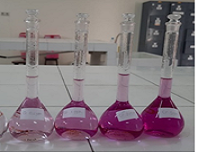Reaction Stability Test of Hexavalent Chromium Complex with 1,5-Diphenylcarbazide in Analysis using UV Visible Spectrophotometer
Abstract
A reaction stability test of hexavalent chromium complex with 1,5-diphenyl carbazide in analysis using a UV Visible Spectrophotometer has been done in this study. This study aims to find out the colored complex stability for the reaction of chromium hexavalent and diphenyl carbazide in the analysis of hexavalent chromium using a UV Vis spectrophotometer in terms of time. The sample was measured in 540 nm of wavelength with 10, 30, 60, 90, 120, and 180-minute time intervals. Each interval was carried out with two times replications. There were no significant differences in the colored complex until the 180-minute time interval, and the measurement of Cr(VI) concentration showed similar results. This analysis exhibits a level of precision and accuracy, evident from the RPD values below 10 % and the recovery values falling within the range of 90 – 110 %. It means that the reaction of hexavalent chromium complex with 1,5-diphenyl carbazide in analysis using a UV Visible Spectrophotometer is stable.
Downloads

Copyright (c) 2024 Warmiati Warmiati, Wijayanti Wijayanti

This work is licensed under a Creative Commons Attribution-NonCommercial-NoDerivatives 4.0 International License.
Authors who publish with this journal agree to the following terms:
- Copyright on any article is retained by the author(s).
- The author grants the journal, the right of first publication with the work simultaneously licensed under a Creative Commons Attribution License that allows others to share the work with an acknowledgment of the work’s authorship and initial publication in this journal.
- Authors are able to enter into separate, additional contractual arrangements for the non-exclusive distribution of the journal’s published version of the work (e.g., post it to an institutional repository or publish it in a book), with an acknowledgment of its initial publication in this journal.
- Authors are permitted and encouraged to post their work online (e.g., in institutional repositories or on their website) prior to and during the submission process, as it can lead to productive exchanges, as well as earlier and greater citation of published work.
- The article and any associated published material is distributed under the Creative Commons Attribution-NonCommercial-NoDerivatives 4.0 International License.





_copy1.png)










